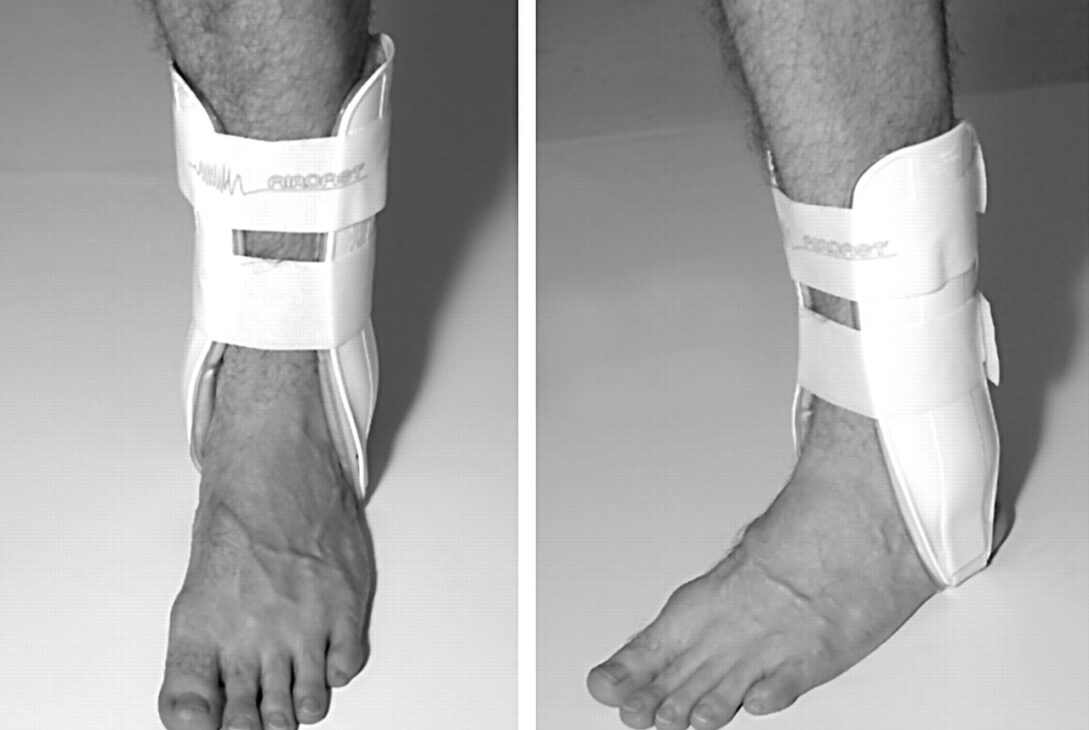If you lead a fairly active lifestyle, you have likely had some kind of ankle-related injury. Perhaps it occurred while you were playing a sport, twisting your ankle the wrong way, or you landed awkwardly on your ankle while out for your morning run. Maybe you have an injury due to overuse, like tendonitis or a stress fracture. Whatever the reason may be, it’s important to allow yourself the appropriate amount of time to heal, and to ensure that you don’t reinjure it when you get back to your normal levels of activity.
It’s usually tempting to get right back to your normal routines once the pain and swelling have subsided, but this can be one of the most vulnerable periods for reinjuring yourself, as your ankle still needs the proper support to give you the best chance of avoiding reinjury. When considering your options for maintaining proper support, there are two main methods: taping and bracing.
Ankle Taping
Ankle taping usually involves the use of a specialized rigid variety of sports tape, specifically designed to hold and support. There is an alternative option for taping called Kinesiology Tape, which provides a greater range of movement, but less support compared to rigid tapes. It is best to consult your physician to see what product is best for you, as it is highly dependent on your individual situation.
There is an ideal method in terms of how to tape ankles properly and effectively, and we recommend watching this how-to video as your starting point. If you are just starting out and have little experience with taping ankles, it’s usually a good idea to get a more experienced person to apply it the first time, like your physiotherapist. Taping ankles correctly requires some practice, and you ideally don’t want to reinjure yourself due to inexperience. It is also recommended to bring your phone to capture a video of your ankle being taped for reference later at home.
As with any tapes, it’s probably a good idea to remove any leg hair around the area you are taping, as it will better adhere to your skin and provide proper support, and also be less painful when taking the tape off later.
There are a great many benefits to ankle taping. Due to the fact that the tape itself is very low profile and doesn’t offer too much in the way of additional bulk, it feels quite comfortable in a short term situation. It is also a cheaper short-term option, as only requiring a few applications means using relatively small amounts of tape, and leave you more of the roll for future applications.
Unfortunately, the disadvantages to taping pile up the longer you use it. Repeated applications require more tape, and it can get fairly expensive quickly. Each application also comes with the risk that the tape had been applied incorrectly, and does not provide the proper support to avoid reinjury. With how tricky tape can be to apply, it could also mean that reapplications are necessary, which leads to wasted tape. Additionally, tapes can be irritants if they are used for extended periods of time, especially if they become loose and rub against the skin. Others may find that they are allergic to certain types of adhesives used in the tape. While rare, it is important to initially monitor yourself closely to ensure you are not experiencing these reactions. Overall, you will likely need a decent amount of practice to get this down properly, and it might prove to be costly if being used as a long-term solution.
Ankle Bracing
Ankle braces are the alternative to traditional taping that use adjustable sleeves, which fit firmly over the ankle. There are a variety of different types of braces on the market for different consumers’ needs, but there are some braces that are generally accepted to be better than others. This method is very good at mimicking the effects of taping, and is much easier to apply yourself than the traditional taping methods.
For long-term use, braces are very cost-effective. Good braces hold up very well for extended periods of time, and usually result in a one-time expense. With the adjustable straps, they are also very easy to adjust for comfort and support if needed. They also come with a low probability of skin irritation, as they are designed to be worn long-term.
Naturally, these braces are associated with a much more sizable short-term cost, and may not be the economical choice for a short-term need. More people also find braces uncomfortable to wear despite the adjustability, so it’s a good idea to test for yourself before committing to it long-term. Finally, braces also tend to be bulkier, and much more difficult to accommodate in tighter footwear.
Which Is Better?
Of course, usually with anything, the right choice is highly dependent on your individual situation. There are advantages to both methods of support, and will likely require some experimentation to see what makes the most sense for you. Generally speaking, there are a few trends on how to choose, which might make your decision process a little easier.
- There are some people who simply cannot wear tape, either due to allergies to the adhesives or tape materials, or due to frail or sensitive skin, which can be at higher risk to damage when in contact with strong adhesives. In these situations, ankle bracing is your only realistic option.
- If the use of tape does not carry these restrictions and applied properly, taping is likely your best option in the short-term, as it is likely the more comfortable and cost-effective option.
- If you need long-term support or require continued use for longer periods of time, ankle braces are likely your best option due to long-term cost effectiveness, on the condition that you can discover a brace which fits your shoe requirements.
These are general guidelines that should help you to get started, but there are lots of other factors that may contribute to your decision, including the precise area of injury and the level of instability. Remember that while taping or bracing are good preventative techniques, they should not be used as an entire treatment without proper rehabilitation. Always consult with your physician to find the best course of action for you.
Author’s Bio
Colin Hegarty is a content writer for BreezeMaxWeb that helps businesses showcase their brand through enticing copy. When he’s not working, you can find him playing net in a local beer league or biking around the city.







![ExtraTorrents Proxy List For 2020 [100% Working Proxies To Unblock Extratorrents] ExtraTorrents Proxy List For 2020 [100% Working Proxies To Unblock Extratorrents]](https://www.troozer.com/wp-content/uploads/2020/08/extratorrent-cd-640x360-1-250x250.jpg)



